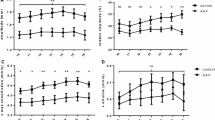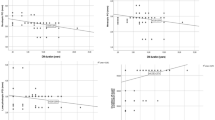Abstract
Objective
To study the degree of pupillary impairment in diabetic and non-diabetic autonomic neuropathy.
Methods
We retrospectively sampled from all patients who underwent comprehensive autonomic testing and infrared pupillometry at UT Southwestern Medical Center. Composite autonomic severity score (CASS) and pupillary indices from the average of at least three pupillary response curves were recorded. We randomly matched patients with diabetic autonomic neuropathy (DAN) and patients with autonomic impairment unrelated to diabetes (non-DAN) based on gender, age (±5 years), and CASS (±1 point). We used the paired t test to analyze differences between the groups.
Results
We identified 40 patients with DAN and 40 matched controls with non-DAN. M:F ratio was 1:1. Mean CASS was 4.2 and mean age was 62.4 years. Six had type I and the rest had type II diabetes mellitus. Both absolute constriction amplitude (ACA) and maximum constriction velocity (MCV) were significantly lower in DAN compared to non-DAN; mean ACA was 0.9 mm vs. 1.17 mm (p = 0.0077) and mean MCV was 2.8 vs. 3.6 mm/s (p = 0.0039). Severely diminished MCV for age was noted in 48 % of diabetic and in only 28 % of non-DAN patients. The ACA-corrected time to 75 % re-dilation was significantly delayed in DAN vs. non-DAN [mean 3.2 vs. 1.7 s/mm (p = 0.025)]. A statistically significant decline was noted for both the MCV and ACA with higher cardiovagal subscores among DAN patients.
Conclusions
Parasympathetic and sympathetic pupillary dysfunction appears to be a common feature of autonomic impairment in diabetes compared to non-diabetic causes of autonomic impairment.



Similar content being viewed by others
References
Vinik AI, Maser RE, Mitchell BD, Freeman R (2003) Diabetic autonomic neuropathy. Diabetes Care 26:1553–1579
Maser RE, Mitchell BD, Vinik AI, Freeman R (2003) The association between cardiovascular autonomic neuropathy and mortality in individuals with diabetes: a meta-analysis. Diabetes Care 26:1895–1901
Tesfaye S, Boulton AJ, Dyck PJ, Freeman R, Horowitz M, Kempler P, Lauria G, Malik RA, Spallone V, Vinik A, Bernardi L, Valensi P, Toronto Diabetic Neuropathy Expert G (2010) Diabetic neuropathies: update on definitions, diagnostic criteria, estimation of severity, and treatments. Diabetes Care 33:2285–2293
Vinik AI, Ziegler D (2007) Diabetic cardiovascular autonomic neuropathy. Circulation 115:387–397
Pittasch D, Lobmann R, Behrens-Baumann W, Lehnert H (2002) Pupil signs of sympathetic autonomic neuropathy in patients with type 1 diabetes. Diabetes Care 25:1545–1550
Schwingshandl J, Simpson JM, Donaghue K, Bonney MA, Howard NJ, Silink M (1993) Pupillary abnormalities in type I diabetes occurring during adolescence. Comp Cardiovasc Reflex Diabetes Care 16:630–633
Ferrari GL, Marques JL, Gandhi RA, Heller SR, Schneider FK, Tesfaye S, Gamba HR (2010) Using dynamic pupillometry as a simple screening tool to detect autonomic neuropathy in patients with diabetes: a pilot study. Biomed Eng Online 9:26
Cahill M, Eustace P, de Jesus V (2001) Pupillary autonomic denervation with increasing duration of diabetes mellitus. Br J Ophthalmol 85:1225–1230
Low PA (1993) Composite autonomic scoring scale for laboratory quantification of generalized autonomic failure. Mayo Clin Proc 68:748–752
Muppidi S, Adams-Huet B, Tajzoy E, Scribner M, Blazek P, Spaeth EB, Frohman E, Davis S, Vernino S (2013) Dynamic pupillometry as an autonomic testing tool. Clin Auton Res Off J Clin Auton Res Soc 23:297–303
Bremner F (2009) Pupil evaluation as a test for autonomic disorders. Clin Auton Aes Off J Clin Auton Res Soc 19:88–101
Smith SA, Smith SE (1999) Bilateral Horner’s syndrome: detection and occurrence. J Neurol Neurosurg Psychiatry 66:48–51
Campanucci V, Krishnaswamy A, Cooper E (2010) Diabetes depresses synaptic transmission in sympathetic ganglia by inactivating nAChRs through a conserved intracellular cysteine residue. Neuron 66:827–834
Pena MM, Donaghue KC, Fung AT, Bonney M, Schwingshandl J, Howard NJ, Silink M (1995) The prospective assessment of autonomic nerve function by pupillometry in adolescents with type 1 diabetes mellitus. Diabet Med J Br Diabet Assoc 12:868–873
Thompson S (2012) Pupillometry: a clinical measure of retinal function in inherited disease. Invest Ophthalmol Vis Sci 53:5570
Giza E, Fotiou D, Bostantjopoulou S, Katsarou Z, Gerasimou G, Gotzamani-Psarrakou A, Karlovasitou A (2012) Pupillometry and 123I-DaTSCAN imaging in Parkinson’s disease: a comparison study. Int J Neurosci 122:26–34
Yamashita F, Hirayama M, Nakamura T, Takamori M, Hori N, Uchida K, Hama T, Sobue G (2010) Pupillary autonomic dysfunction in multiple system atrophy and Parkinson’s disease: an assessment by eye-drop tests. Clin Auton Res Off J Clin Auton Res Soc 20:191–197
Conflict of interest
The authors declare that they have no conflict of interest.
Ethical standards
This study was approved by the local institutional review board.
Author information
Authors and Affiliations
Corresponding author
Rights and permissions
About this article
Cite this article
Yuan, D., Spaeth, E.B., Vernino, S. et al. Disproportionate pupillary involvement in diabetic autonomic neuropathy. Clin Auton Res 24, 305–309 (2014). https://doi.org/10.1007/s10286-014-0258-6
Received:
Accepted:
Published:
Issue Date:
DOI: https://doi.org/10.1007/s10286-014-0258-6




